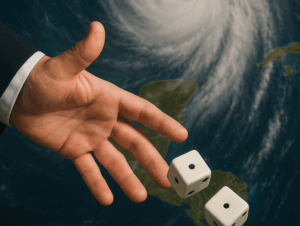Lists published every hurricane season, adjusting the amounts of insurance losses for past events for inflation to current-dollar levels, give a misleading picture of the potential for a single event costing insurers $100 billion.
Karen Clark & Company (KCC) offered that assessment in a new white paper, “The $100 Billion Hurricane: How and Where it Can Happen.” The paper identifies five past events that would result in over $100 billion in losses today—including one that would top $200 billion—by adjusting for property exposure changes.
An online search for a more typical compilation using changes in the Consumer Price Index over time points to just one event that would produce $100 billion in insurance losses today—Hurricane Katrina, which resulted in $65 billion in insured losses in 2005.
In fact, while the KCC report indicates that a repeat of 2005, with five landfalling hurricanes, would contribute to a $100 billion annual loss total, the single event would not breach the $100 billion threshold by itself, KCC estimates reveal.
According to a National Weather Service review of Katrina’s path 20 years ago, the storm first made landfall as a Category 1 hurricane in southeast Florida, and then twice more, at Category 3 strength on Louisiana and Mississippi’s Gulf Coast.
“As a point of reference, coastal exposures have tended to just about double every 10 years,” the white paper says, stressing the importance of including changes in the numbers, locations and values of residential and commercial properties and autos in any true-up of past-event losses to current levels.
“A major hurricane striking a highly populated metropolitan area could easily cause over $100 billion in insured losses today,” the KCC report says, identifying the Florida tri-county area of Miami-Dade, Broward and Palm Beach—with over $2 trillion in combined insured property values—as one of three spots where a $100 billion hurricane could occur.
Galveston/Houston and the Northeast are the other two hurricane locations that could result in insured loss figures written with 12 digits after the dollar sign.
The report recalibrates the Great Miami Hurricane of 1926, the 1900 Galveston Hurricane and two other pre-1960 events that would cause extensive damage to the insurance industry by examining the property exposures currently sitting in the areas that were hit more than half a century ago. After 1960, there was only one hurricane that would cause $100 billion-plus insured losses: Hurricane Andrew in 1992.
“The U.S. has been lucky” since then. In the past 25 years, there have been 16 landfalling major hurricanes, but none of these storms made landfall directly within a major metropolitan area such as Miami or Houston,” the KCC report notes.
“The Northeast U.S. has not experienced a major hurricane for decades.”
The white paper notes a particular stroke of luck that came in 2017, when Hurricane Irma did not follow a forecasted track that would have put a Category 4/5 hurricane near Miami.
 Given Irma’s near miss, no major hurricane made landfall in the Florida tri-county area since 2000, the white paper says. In contrast, from 1926 to 1950, six Category 4 or 5 storms did. That includes the Great Miami Hurricane of 1926, which would produce $200-billion-plus insured losses today, based on KCC estimates of impacted populations and property exposures now—even considering improvements in building codes and construction practices since 1926.
Given Irma’s near miss, no major hurricane made landfall in the Florida tri-county area since 2000, the white paper says. In contrast, from 1926 to 1950, six Category 4 or 5 storms did. That includes the Great Miami Hurricane of 1926, which would produce $200-billion-plus insured losses today, based on KCC estimates of impacted populations and property exposures now—even considering improvements in building codes and construction practices since 1926.
The report includes graphs illustrating the dependence of insured losses on exact landfall location—one showing industry losses from a Category 5 hurricane hitting 40-plus different locations in Texas, and another illustrating insured loss amount differences for a Category 3 hitting 22 different towns in the Northeast.
Category 3s falling in Queens or Long Beach, N.Y., would breach the $100 billion level, while likelier spots on the east end of Long Island would generate about half the amount ($40-$50 billion in insured losses).
While storm trajectories make a Cat 5 or even a Cat 4 unlikely to hit the Northeast, “it is only a matter of time” before a Category 5 makes landfall along the Texas coastline, the KCC white paper notes. The graph indicates $350 billion in estimated insured losses for a Cat 5 hitting Galveston.
Katrina Today: Swiss Re’s Take
About a month before KCC published its report on the impact of maximum hurricane losses in each year dating back to 1900 based on 2025 exposures, Swiss Re provided a separate take on one particular storm: 2005’s Hurricane Katrina.
“New Orleans never fully recovered. Its population remains 20 percent lower than pre-Katrina levels, and GDP has not returned to its prior growth trajectory,” wrote Adrian Hall, CEO of United States at Swiss Re Corporate Solutions in a blog item titled, “Katrina at 20: lessons in resilience for the next generation of risk.”
Taking population and other variables into account—including flood defenses and resilient building design—Swiss Re used in-house models and industry exposure databases to simulate a Katrina redo today—putting the insured loss total close to $100 billion in 2024 prices.
That’s slightly lower than the inflation-adjusted loss of $105.4 billion, Swiss Re notes.
There are “profoundly different reasons” for the similarity between the inflation-adjusted cost and the modeled estimate of insured losses from a Katrina-like storm striking New Orleans in 2025, Hall noted. “The reduction in damages would be due to enhanced flood defenses, improved building codes, and smarter land use—not merely luck or lower storm intensity,” he wrote.
“This is a triumph of adaptation,” he said, noting that federal and state governments invested nearly $15 billion in the “Hurricane Storm Damage Risk Reduction System (HSDRRS), a levee and pump infrastructure that shielded New Orleans during Hurricane Ida in 2021.”
“Louisiana also introduced its first statewide building code, joining other Gulf states in strengthening resilience,” he wrote.
Going on to focus on the “more sobering” component of the lower cost estimate—the dip in the population—he wrote: “Fewer people and assets in harm’s way reduce exposure, but at the cost of community vitality and economic resilience.”
The balance of Hall’s piece is a call to action for commercial real estate owners and managers, manufacturing facilities, logistics hubs, and retail centers located in hurricane-prone regions to go beyond minimum compliance by engaging in pre-disaster planning, retrofitting buildings to modern standards, engage in community resilience planning and regularly auditing insurance coverage.
The KCC report concludes with a section stressing the need to replace rules of thumb for managing risk concentrations—such as tracking market share in each ZIP code and keeping them below specified percentages. Better risk management is based on analyses that pay attention to the changing characteristics of hurricanes along the nation’s coastlines, the paper suggests.
Along these lines, the paper briefly outlines KCC’s 100-year characteristic event (CE) methodology, introduced over a decade ago. An illustrative graph in the report shows a hypothetical company’s losses (based on its portfolio) for 100-year-hurricanes calculated at different landfall points spaced every 10 miles along the coast from Brownsville, Texas to Edgartown, Mass.
Related articles by Karen Clark: Karen Clark Explains The Basic Facts About Hurricanes (2013); What Boards Would Like to Know About Catastrophe Losses (2014); Hurricane Katrina’s Legacy (2015)
Images: AI-generated (ChatGPT and Adobe/Firefly)
Was this article valuable?
Here are more articles you may enjoy.



 Top National Insurance Journal Stories of 2025
Top National Insurance Journal Stories of 2025  FBI Involved After Two Florida Injury Lawyers Go Missing From Fishing Trip
FBI Involved After Two Florida Injury Lawyers Go Missing From Fishing Trip  Court Ruling Could Help Shed Light on Owners of Litigation Funders, Medical Clinics
Court Ruling Could Help Shed Light on Owners of Litigation Funders, Medical Clinics  Brown & Brown Files Suit Over Alleged Howden Poaching of 200+ Employees
Brown & Brown Files Suit Over Alleged Howden Poaching of 200+ Employees 

